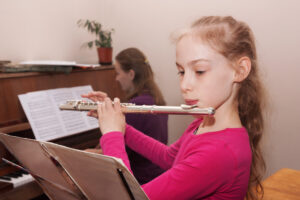 Whether your child has decided they want to learn to play the flute or you are a later beginner, selecting the right flute can be overwhelming with the wide variety of selection available and technical variables to consider. As the flute is made from metal, many beginner flutes are going to be somewhat pricier than other entry level instruments. This being said, I have seen many decently made instruments on the market at affordable prices that can be used for Flute Lessons in Houston, and from my student’s experience I have discovered that these flutes sound great, are constructed solidly, and can be ideal for any beginner flutist.
Whether your child has decided they want to learn to play the flute or you are a later beginner, selecting the right flute can be overwhelming with the wide variety of selection available and technical variables to consider. As the flute is made from metal, many beginner flutes are going to be somewhat pricier than other entry level instruments. This being said, I have seen many decently made instruments on the market at affordable prices that can be used for Flute Lessons in Houston, and from my student’s experience I have discovered that these flutes sound great, are constructed solidly, and can be ideal for any beginner flutist.
Let’s look at several features to consider when purchasing a beginner flute to help you make an informed decision when purchasing a beginner flute and help get you or your child get started with a Flute Teacher in Houston!
Curved vs. Straight Headjoint
Flutes are made of three connecting pieces: headjoint, body, and footjoint. When younger students start out on the flute, depending on the student they may have trouble with the reach of the standard straight headjoint. Fortunately, there is an alternative curved headjoint designed to lessen this reach for smaller children, offering them the opportunity to play the flute comfortably so they can focus on making a focused sound and reach all of the keys with ease.
Some beginner flutes come with both headjoints, an extremely convenient option as each child will grow into the straight headjoint at differing rates, and some headjoints have to be adjusted to fit different flutes. Also, the price is usually fairly reasonable for these flutes considering you will not have to purchase a headjoint separately when the need for a straight headjoint arises.
Offset vs. Inline G Key
Another feature to consider when purchasing a beginner flute is whether to go with the offset or inline G key.
An offset G has the G key aligned in a more ergonomic fashion for the left hand ring finger. This feature makes the reach to this key more comfortable for most people, and nowadays most flutes are made with the offset G.
On the contrary, the inline G key has this key placed in line with the surrounding keys. Some people do find this comfortable, and is something to consider when trying out flutes.
C Footjoint vs. B Footjoint
Another feature to consider is whether to purchase a flute with a C or B footjoint. Most beginner flutes will be equipped with the C footjoint, on which the C below the staff is the lowest note. The B footjoint has one additional key and will play down to low B.
In the standard repertoire, the low B is very rarely required, making the B footjoint unnecessary for a beginner. Eventually most flutists will want to upgrade to a B foot, although some professionals do play on C foot instruments. For the beginner, a C foot instrument is not only perfectly acceptable but also more common.
Open vs. Closed Hole Keys
Open hole flutes have holes in the keys designed to be covered by the player’s fingers when pressed. This requires the player to have very precise finger action in order to fully cover the holes, which becomes especially evident in rapid fingering passages.
Closed holed instruments are easier for the beginner to play, as initially it can be difficult to hold the instrument properly, let alone cover the keys perfectly.
Most beginner flutes have closed hole keys, although an open hole instrument is a necessary upgrade for the serious flutist as it allows for greater tone projection and extended techniques such as bending and sliding notes.
There are relatively affordable beginner flutes on the market which have open hole keys, and in my opinion this can be a great option for the beginner flutist. To get around the inability to cover all of the holes, there are plugs designed to be inserted into the holes and removed gradually as technique improves. I usually have my students take out one or two holes at a time to transfer over to completely uncovered keys.
Starting out on an open hole instrument gives the player the advantage of developing an efficient finger technique as a beginner. This being said, a student can still develop good technique on a closed hole flute, which is also the more common route for the beginner flutist. You can find additional resources online for learning music to further improve your technique.
There is a great flute out there for every beginner flutist and for every budget. And when your child is ready to start learning, you can check out Lessons in Your Home. At Lessons In Your Home, our instructors are thoroughly vetted, professional, and passionate about music. Our teachers will come right to their home for every lesson, plus we offer virtual music lessons, too. Our online music lessons are being taught by local music teachers with live lessons tailored to every student! Contact us today to learn more.
By Jennifer Ridout
